
by Matt Lollar | Nov 8, 2018
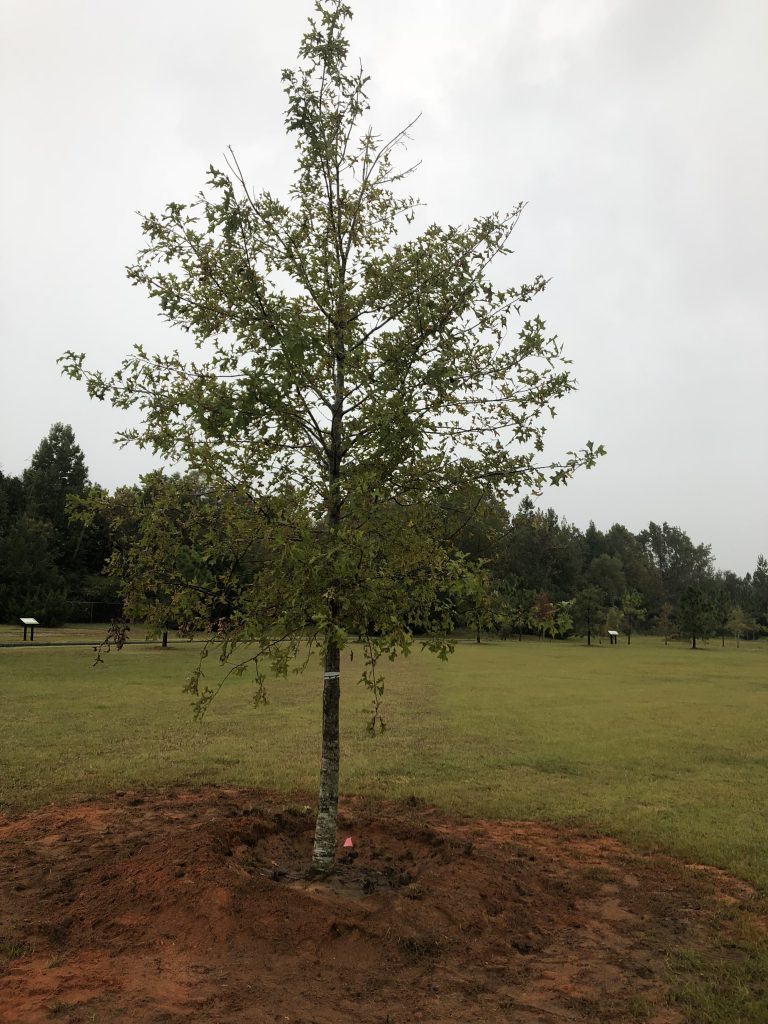
A planted tree with water retention berm. Photo Credit: Matt Lollar, University of Florida/IFAS Extension – Santa Rosa County
Often, Extension agents are tasked with evaluation of unhealthy plants in the landscape. They diagnose all sorts of plant problems including those caused by disease infection, insect infiltration, or improper culture.
When evaluating trees, one problem that often comes to the surface is improper tree installation. Although poorly installed trees may survive for 10 or 15 years after planting, they rarely thrive and often experience a slow death.
Fall is an excellent time to plant a tree in Florida. A couple of weeks ago beautiful Nuttal Oak was planted at Bagdad Mill Site Park in Santa Rosa County, FL. Here are 11 easy steps to follow for proper tree installation:
- Look around and up for wire, light poles, and buildings that may interfere with growth;
- Dig a shallow planting hole as wide as possible;
- Find the point where the top-most root emerges from the trunk;
- Slide the tree carefully into the planting hole;
- Position the point where the top-most root emerges from the trunk slightly above the landscape soil surface;
- Straighten the tree in the hole;
- Remove synthetic materials from around trunk and root ball;
- Slice a shovel down in to the back fill;
- Cover the exposed sides of the root ball with mulch and create water retention berm;
- Stake the tree if necessary;
- Come back to remove hardware.
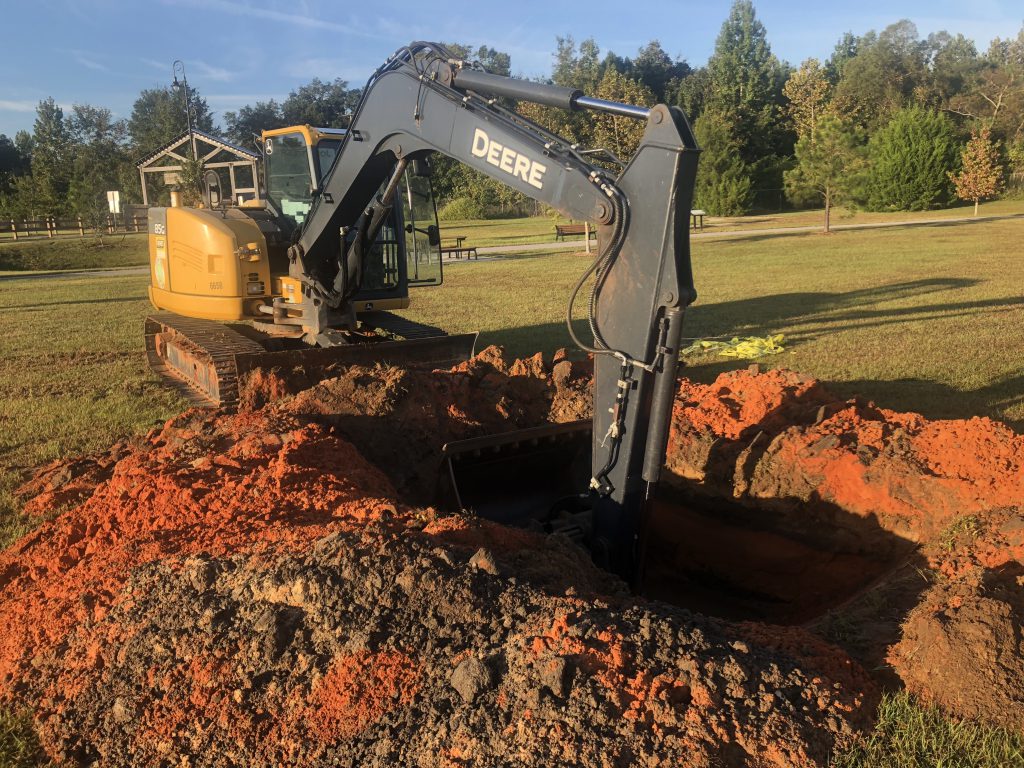
Digging a properly sized hole for planting a tree. Photo Credit: Matt Lollar, University of Florida/IFAS Extension – Santa Rosa County
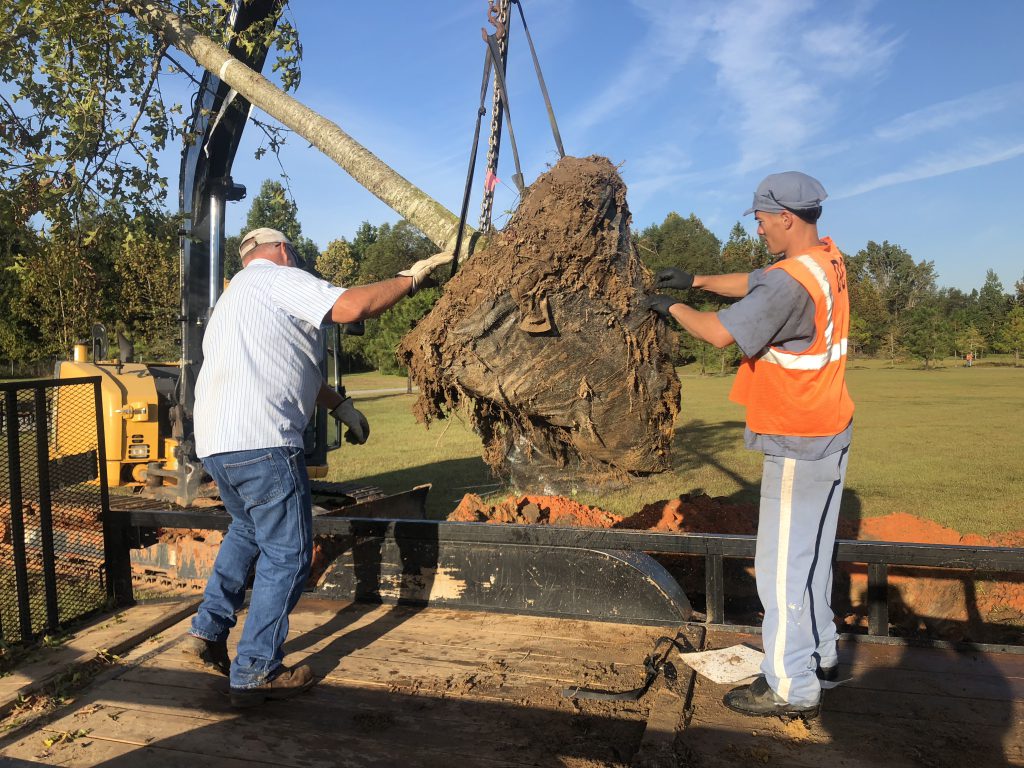
Removing synthetic material from the root ball. Photo Credit: Matt Lollar, University of Florida/IFAS Extension – Santa Rosa County
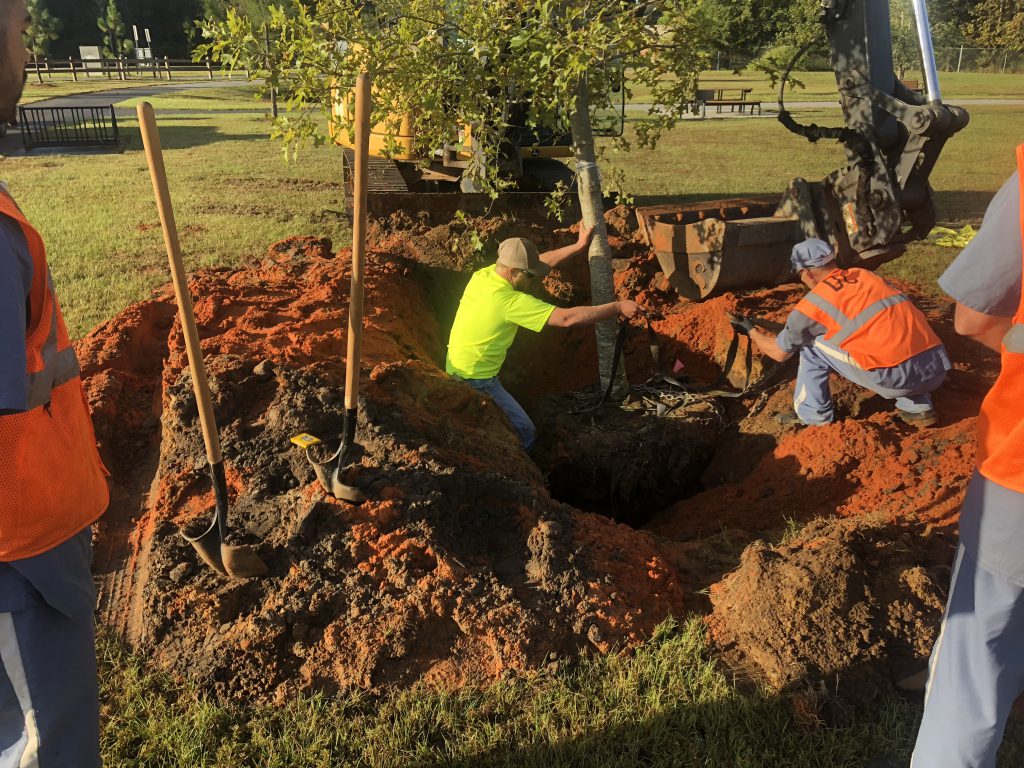
Straightening a tree and adjusting planting height. Photo Credit: Matt Lollar, University of Florida – Santa Rosa County
For more detailed information on planting trees and shrubs visit this UF/IFAS Website – “Steps to Planting a Tree”.
For more information Nuttall Oaks visit this University of Arkansas Website.
by Matt Lollar | Oct 20, 2018
One of my favorite native plants is winged sumac. I like this plant not only for its ornamental beauty, but also for its fruit that can be dried and used as seasoning and to make tea. So you can understand my concern when one of my prized winged sumac plants had distorted leaves.
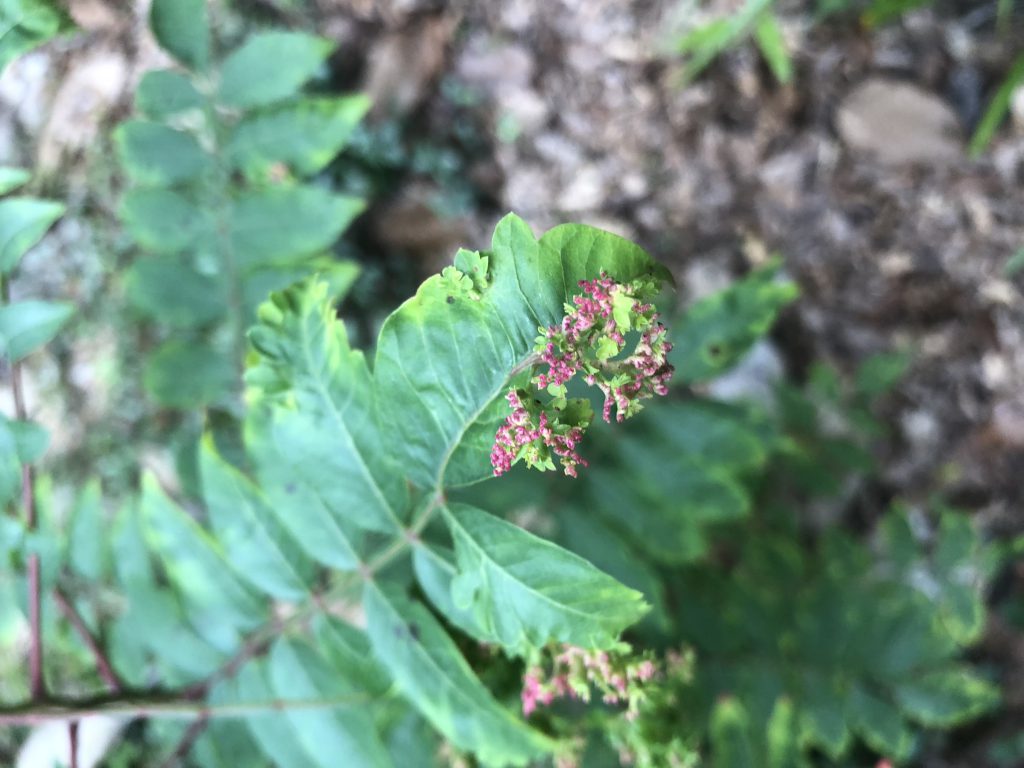
Eriophyid mite damage on winged sumac. Photo Credit: Matt Lollar, University of Florida/IFAS Extension – Santa Rosa County
After doing a little research and speaking with one of our UF/IFAS Specialists, I was able to determine that the leaf distortion was caused by eriophyid mites. Mites are not insects and are more closely related to spiders. They normally have four pairs of legs, however eriophyid mites only have two pairs of legs. They are microscopic, elongate, spindle-shaped, and translucent.

An eriophyid mite. Photo Credit: USDA, Agricultural Research Service.
Eriophyid mites cause galls (sometimes called witch’s broom) on various species of ornamental shrubs. Symptoms include early and late bud distortion, distorted leaves, and possibly plant death. In fact, the species Phyllocoptes fructiphilus is the vector for the viral disease of roses called Rose Rosette Disease. Sometimes the damage can be confused with herbicide damage.
Control options are currently being evaluated for eriophyid mites in the home landscape. Removing distorted plant material and removing it from the site can help prevent the spread of mites. If you suspect eriophyid mites are the cause of your distorted plants then samples should be collected. To collect samples: 1) Prune off symptomatic plant material and immediately place into a vial with rubbing alcohol; 2) label with collection date, plant species, and location; 3) mail to the Landscape Entomology Lab in Gainesville at P.O. Box 110620, Gainesville, FL 32611.
For more information on eriophyid mites and the sampling process, please see the fact sheet “Unusual Galls on Woody Ornamentals” from Erin Harlow and Dr. Adam Dale.
For more information on other mites that could be infesting your landscape, please go to this link from the Mid-Florida Research and Education Center in Apopka, FL.
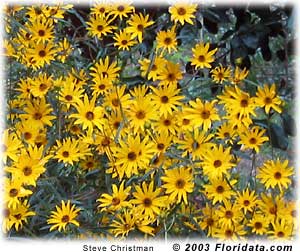
by Sheila Dunning | Oct 2, 2018
 Each fall, nature puts on a brilliant show of color throughout the United States. As the temperatures drop, autumn encourages the “leaf peepers” to hit the road in search of the red-, yellow- and orange-colored leaves of the northern deciduous trees. In Northwest Florida the color of autumn isn’t just from trees. The reds, purples, yellow and white blooms and berries that appear on
Each fall, nature puts on a brilliant show of color throughout the United States. As the temperatures drop, autumn encourages the “leaf peepers” to hit the road in search of the red-, yellow- and orange-colored leaves of the northern deciduous trees. In Northwest Florida the color of autumn isn’t just from trees. The reds, purples, yellow and white blooms and berries that appear on
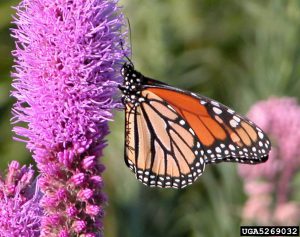
Monarch butterfly on dense blazing star (Liatris spicata var. spicata).
Beverly Turner, Jackson Minnesota, Bugwood.org
many native plants add spectacular color to the landscape. American Beautyberry, Callicarpa americana, is loaded with royal-colored fruit that will persist all winter long. Whispy pinkish-cream colored seedheads look like mist atop Purple Lovegrass, Eragrostis spectabilis and Muhlygrass, Muhlenbergia capillaris. The Monarchs and other butterfly species flock to the creamy white “fluff” that covers Saltbrush, Baccharis halimifolia. But, yellow is by far the dominant fall flower color. With all the Goldenrod, Solidago spp., Narrowleaf Sunflower, Helianthus angustifolius and Tickseed, Coreopsis spp., the roadsides are golden. When driving the roads it’s nearly impossible to not see the bright yellows in the ditches and along the wood’s edge. Golden Asters (Chrysopsis spp.), Tickseeds (Coreopsis spp.), Silkgrasses (Pityopsis spp.), Sunflowers (Helianthus spp.) and Goldenrods (Solidago spp.) are displaying their petals of gold at every turn. These wildflowers are all members of the Aster family, one of the largest plant families in the world. For most, envisioning an Aster means a flower that looks like a daisy. While many are daisy-like in structure, others lack the petals and appear more like cascading sprays. So if you are one of the many “hitting the road in search of fall color”, head to open areas. For wildflowers, that means rural locations with limited homes and businesses. Forested areas and non-grazed pastures typically have showy displays, especially when a spring burn was performed earlier in the year. Peeking out from the woods edge are the small red trumpet-shaped blooms of Red Basil, Calamintha coccinea and tall purple spikes of Gayfeather, Liatris spp.
Visit the Florida Wildflower Foundation website, www.flawildflowers.org/bloom.php, to see both what’s in bloom and the locations of the state’s prime viewing areas. These are all native wildflowers that can be obtained through seed companies. Many are also available as potted plants at the local nurseries. Read the name carefully though. There are cultivated varieties that may appear or perform differently than those that naturally occur in Northwest Florida. For more information on Common Native Wildflowers of North Florida go to http://edis.ifas.ufl.edu/ep061
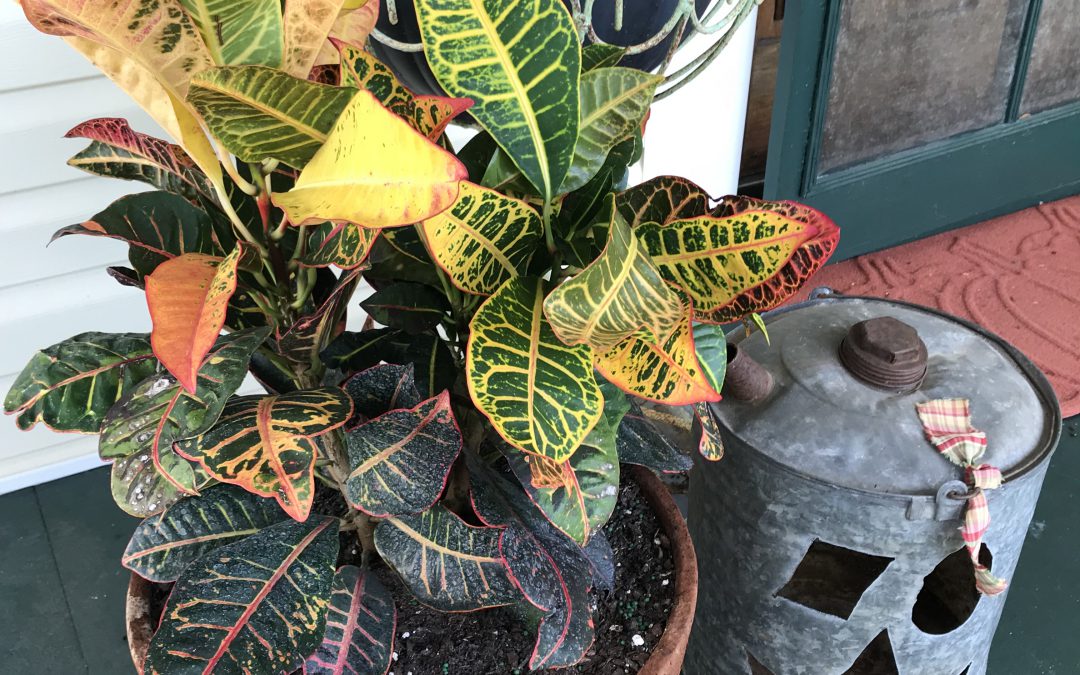
by Daniel J. Leonard | Sep 25, 2018
Florida is known for many things, however sweeping vistas of hillsides covered in the orange, red, and yellow foliage of fall is not one of them. Our long, hot summers and short, cool (not cold) winters, and lack of anything of substance resembling a season in between, precludes the fall color show our neighbors to the north enjoy. Don’t settle for synthetic Halloween decorations or faux painted leaves to add festivity to the autumn landscape design. When football season kicks off and summer blooming annuals begin to fade, it’s time to reach into the horticultural toolbox and pull out a couple fall-y Florida Friendly annual foliage species, perfect for the balmy Panhandle “autumn”: ‘Alabama Sunset’ coleus and ‘Petra’ croton.
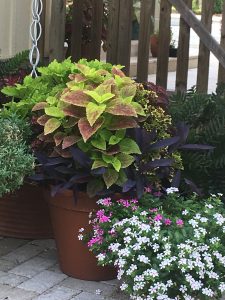
‘Alabama Sunset’ Coleus in mixed container – Photo Courtesy Andrea Schnapp
The first plant to consider when looking for outstanding heat tolerant foliage is the common coleus (Solenostemon scuttellarioides), particularly the cultivar ‘Alabama Sunset’. As the name indicates, ‘Alabama Sunset’ offers leaves in shades of red and yellow, perfect for designing fall containers or mixing into planting beds. This popular summer annual is known for its ability to add interesting color and texture to shady areas.
Recently with the arrival of the ‘sun coleus’ series (to which ‘Alabama Sunset’ belongs), coleus is permissible in situations with greater sunlight. Coleus is incredibly easy to grow and easy to find since nearly every nursery stocks at least a few cultivars. What’s more, these plants are generally free of pests and disease problems! Even sun coleus does appreciate a little protection from the hot afternoon sun and occasional deadheading of flowers.

‘Petra’ Croton. Photo courtesy Daniel Leonard.
The second plant in the fall foliage arsenal is ‘Petra croton’ (Codiaeum variegatum ‘Petra’). Primarily known as a tropical foliage or indoor houseplant, Petra croton is criminally underused in fall landscape and container design. Petra croton sports bold magnolia-sized leaves striped with colors of yellow, red, orange, and black. A great Halloween plant to complement those front-porch Jack-O-Lanterns!
Like coleus, Petra croton is extremely easy to grow either in a container or in the ground. It should be located in either in full sun or partial shade and watered through establishment. Otherwise, this species is quite drought tolerant and can be killed with kindness if watered too frequently!
Although croton is a perennial shrub in the tropics, in Northwest Florida it may be killed by frost and best treated as an annual. Croton can be expected to reach 30-36” in height in a single season, its size and the boldly colored foliage make it a true focal point in the autumn landscape!
Appalachian-grade fall color may be unattainable in the Panhandle in the literal sense, but with these novel plant selections the autumn mood may be present even as the emerald waves hit the sugar white sand. By using annual foliage plants that possess traditional fall colors throughout their life cycle, anyone can add a splash of Autumn to their mixed containers or landscape beds. ‘Alabama Sunset’ coleus and ‘Petra’ croton are the perfect match for this time of year, pairing ease of culture with bold, seasonal color. Plant a couple today!
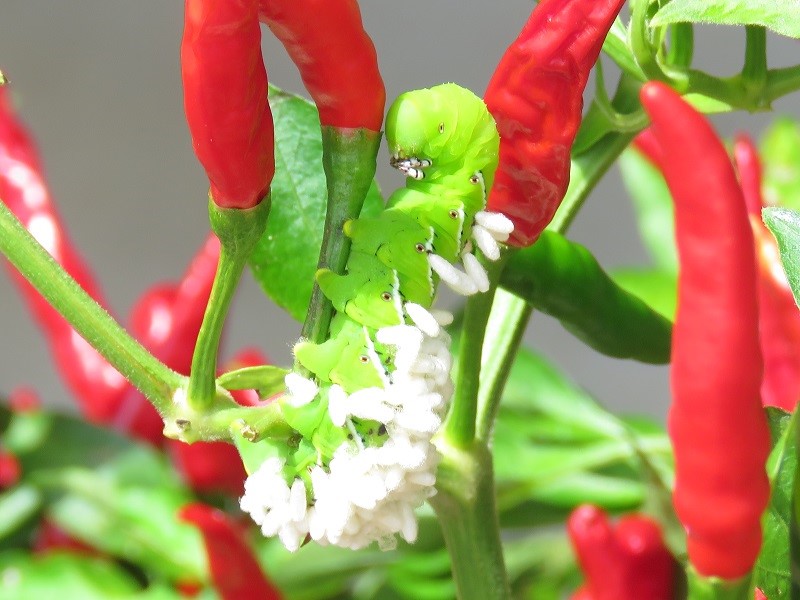
by Carrie Stevenson | Sep 18, 2018
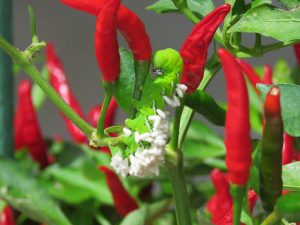
This tomato hornworm is being parasitized by beneficial wasps. Photo credit: Henry Crenshaw
Why would anyone allow dozens of wasps to thrive in their garden? Why would they let caterpillars keep moving through their pepper bushes? Don’t they know you can spray for that?
As Extension agents, one of the tenets we “preach” in gardening is the concept of Integrated Pest Management (IPM). This technique involves a series of insect control measures that begin with the “least toxic” method of control, using chemicals as a last resort. One of those least toxic measures is “biological control”, in which a natural predator or parasite is recognized and allowed to remove a pest insect naturally. It is important to be able to recognize some of the more common garden predators and parasites. Many times these insects look strange or dangerous, and they are mistaken for pests and killed.
One such beneficial insect to the home gardener is the braconid wasp (Cotesia congregatus). Most people shudder at the mention of wasps, but these tiny (1/8 inch long), mostly transparent wasps are of no danger to humans. Quite the opposite–they are an excellent addition to gardens, especially if you are growing tomatoes or peppers. One of the major pests to these favorite vegetables is the tomato hornworm (Manduca quinquemaculata), a fat green and white-striped caterpillar.
The beneficial wasp can control hornworms because females lay eggs under the caterpillar’s skin, after which the eggs hatch and larvae feed on the hornworm. After eating through the caterpillar, they form dozens of tiny white cocoons on the caterpillar’s skin. The tomato hornworm is rendered weak and near death, and the vegetable crop is saved.
If you happen to find a tomato hornworm covered in these small oval cocoons, consider yourself lucky. Let the process continue, allowing the new generation of beneficial wasps to hatch and continue their life cycle. They will control any future hornworms in your garden, and the whole process is fascinating to watch!
For questions on integrated pest management, beneficial insects, or growing peppers and tomatoes, call your local County Extension office.
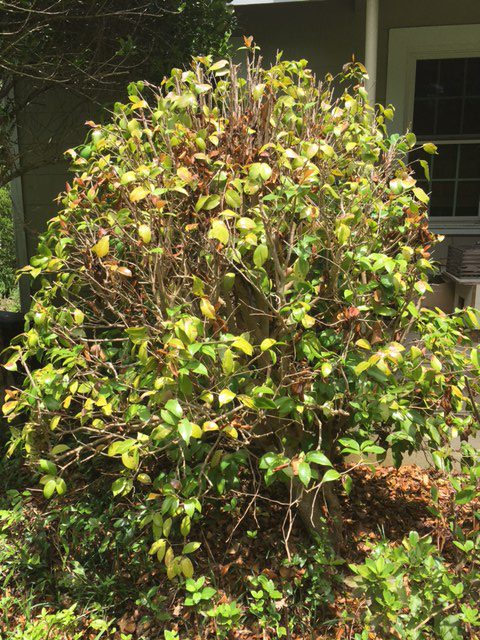
by Matt Lollar | Sep 6, 2018
A few months ago I visited a property that had been renovated to clean up some limbs that were in danger of falling on the house. Pruning tree limbs that are in danger of hitting a structure is always a good idea, but it’s important to look at the impacts this practice may have on the rest of a landscape. Any time the light profile of a landscape is changed, current and future plant selection must be considered. One often seen example occurs when trees grow to full size and shade out the lush lawn that’s underneath. However, in this case, removal of limbs allowed more light to shine on some beautiful, old camellia bushes.
Camellia Planting and Care
Camellias do best in locations that receive filtered sunlight and are protected from the wind. They like acidic, well-drained soils. Trees and shrubs are generally planted 2″ to 3″ above the soil grade. (2″ to 3″ of root ball should be exposed above the soil grade when the tree/shrub is planted.) To help improve root oxygen exposure and help prevent a root rot situations, camellias can be planted slightly shallower than the previously stated recommendation. For more plant establishment guidelines, please visit: UF/IFAS Planting and Establishing Trees Guide
Scenario and Diagnosis
As mentioned above, the property in question was visited to diagnose sick camellia bushes. Upon further inspection of the property, asking about recent changes to the landscape, and inspecting the bushes, it was clear that the camellias were receiving too much sunlight. Sunlight damage was expressed by large brown sunscald spots on the yellowing leaves.
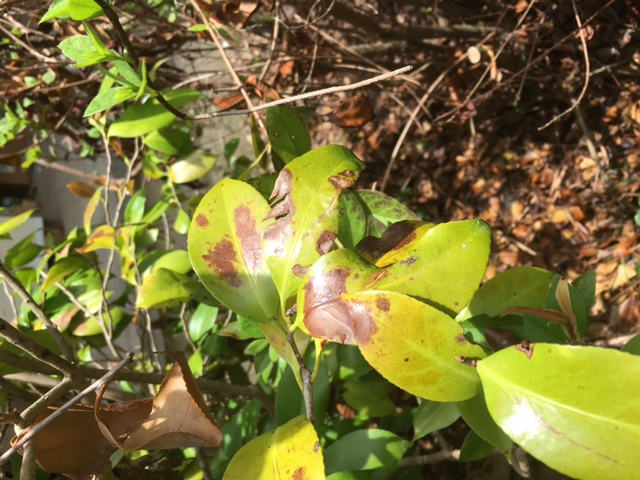
Sunscald damage on camellia leaves. Photo Credit: Jed Dillard
The camellias had also been pruned incorrectly. Camellias require minimal pruning. They are normally pruned to control size or promote a tree form structure if desired. Any pruning should be done before flower buds form in late summer.

An incorrectly pruned camellia bush. Photo Credit: Jed Dillard
Solution
The best solution in this scenario was to dig up the affected camellias and move them to a location with more shade. Sun loving shrubs were suggested as options to replace the camellia bushes. It’s important to note that Camellia sasanqua cultivars are usually more tolerant of sunlight than Camellia japonica cultivars. The recommendations were based on the Florida Friendly Landscaping principle of “Right Plant, Right Place”.
If you’re trying to find the right plants for you own yard, then you should check out the Florida Friendly Landscaping Interactive Plant Database. The database gives you plant selection options for each area of your yard based on location in the state, plant type, and soil and light conditions.

















